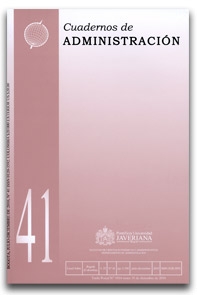Abstract
Advances in technology and in the different businesses that it backs have been supported by Internet information exchange. Therefore, based on the evolution of business models and, in particular, of the analysis of the collaborative commerce (e-commerce) model, this article proposes an implementation methodology consisting of integrating inter-business processes, based on three types of analysis: conceptual, structural, and functional analyses. The purpose of this type of integration of processes and of roles is to enhance value chains from the supplier to the end consumer, generating programming in sync with the infrastructure that each one of the businesses involved in the logistics collaboration contributes.
Ahuja, M.; Galletta, D. and Carley, K. (1998). Individual centrality and performance in virtual groups. Working Paper. Tallahassee, FL: Florida State University.
Akhavi, F. and Hayes, C. (2003). A comparison of two multi-criteria decision-making techniques. IEEE International Conference on Systems,Man and Cybernetics, 1, 956-961.
Andraski, J. (2003). CPFR emerges as the next movement in supply chain management. En D. Seifert (Ed.), Collaborative planning, forecasting, and replenishment: How to create a supply chain advantage (pp. 56-69). New York: AMACOM.
Baatz, E. B. (1995). CIO 100- Best practices: the chain gang. CIO 8 (19), 46-52.
Chen, J. C. and Chen, J. (2004). Testing a new approach for learning teamwork knowledge and skills in technical education. Journal of Industrial Technology, 20 (2), 2-10.
Chen, M.; Zhang, D. and Zhou, L. (2005).Empowering collaborative commerce with Web services enabled business process management systems. Decision Support Systems,43 (2), 530-546.
Huang, A. W. and Chuang, T.-R. 2009. Social tagging, online communication, and Peircean semiotics: a conceptual framework. Journal of Information Science,35 (3), 340-357.
Croom, S.; Romano, P. and Giannakis, M. (2000). Supply chain management: An analytical framework for critical literature review. European Journal of Purchasing and Supply Management (6), 67-83.
Duncan, W. (1996). A guide to the project management body of knowledge. Pennsylvania: Project Management Institute.
Ellram, L. M. (1991). Supply chain management: the industrial organization perspective. International Journal of Physical Distribution and Logistics, 21 (1), 13-22.
Flores, F. (1984). Inventando la empresa del siglo XXI. Santiago: Dolmen.
Hale, B. J. (1999). Logistics perspectives for the new millennium. Journal of Business Logistics, 20 (1), 5-7.
Johnsonbaugh, R. (1988). Matemáticas discretas. México: Iberoamericana.
Khan, R. (2003). Evaluating BPM software. Business Integration Journal.
Kracklauer, A. H.; Mills, D. Q. and Seifert, D. (2004). Customer management as the origin of collaborative customer relationship management. En Collaborative customer relationship management: Taking CRM to the next level (pp. 3-6). s. l.: Springer.
La Londe, B. J. and Masters, J. M. (1994). Emerging logistics strategies: blur print for the next century. International Journal of Physical Distribution and Logistics Management, 24 (7), 35-47.
New, S. J. and Payne, P. (1995). Research frameworks in logistics: three models, seven dinners and a survey. International Journal of Physical Distribution and Logistics Management, 25 (10), 60-77.
Onge, A. (1996). New concepts in supply chain management. Modern Materials Handling, 51 (3), 33.
Phan, D. D. (2003) E-Business development for competitive advantages: a case study. Information & Management, 40 (6), 581-590.
Rayport, J. F. and Sviokla, J. J. (1995). Exploiting the virtual value chain. Harvard Business Review, 73 (6), 75-85.
Reichwald, R.; Möslein, K.; Sachenbacher, H.; Englberger, H. and Oldenburg S. (1998). Telekooperation: Verteilte Arbeits-und Organisationsformen. Berlin: Springer.
Rubio, E. (2000). La sociedad del conocimiento, cambio generalizado. Barcelona: Fundación Universitaria Iberoamericana.
Sieber, P. (1998). Virtuelle Unternehmen in der IT-Branche: Die Wechselwirkung zwischen Internet-Nutzung, Strategie und Organisation. Bern: Paul Haupt.
Smith, J. et al. (2007). Global democracy and the world social forums. Boulder, CO: Paradigm Publishers.
Song, J. and Zahedi, M. (1998). Determinants of market strategies in electronic markets. Documento procedente del Fourth Americas Conference on Information Systems, University of Wisconsin, Estados Unidos.
Tamayo, J. (2003). Diseño de una estructura operativa para las empresas en red. Tesis doctoral no publicada, Universidad Politécnica de Catalunya, Barcelona, España.
Tan, K. C. (2001). A framework of supply chain management literature. European Journal of Purchasing and Supply Management (7), 39-48.
Kannan, V. J.; Handfield, R. B. and Ghosh, S. (1999). Supply chain management: an empirical study of its impact on firm performance. International Journal of Operations and Production Management, 19 (10), 1034-1052.
Tan, K. C.; Kannan, V. R, and Handfield, R. B. (1999). Supply chain management: an empirical study of its impact on performance. International Journal of Operations & Production Management, 19(10), 1034-1052.
Varela, F. J. (1988). Conocer: las ciencias cognitivas, tendencias and perspectivas, cartografía de las ideas actuales. Barcelona: Gedisa.
Wang, S. and Archer, N. (2007). Electronic marketplace definition and classification: literature review and clarifications. Journal Enterprise Information Systems, 1 (1), 89-112.
Winograd, T. and Flores, F. (1986). Understanding computers and cognition: a new foundation for design. Reading: Addison-Wesley.
Whipple, T. W.; Zinkhan, G. and Gailey, E. (2008). A taxonomy of information technology enhanced pricing strategies. Journal of Business Research, 61 (4), 275-283.
Yang, M.-H. and Ahuja, N. (1999). Face detection using a mixture of factor analyzers. Documento procedente de The 1998 IEEE International Conference on Image Processing, Kobe, Japan.
This work is licensed under a Creative Commons Attribution-NonCommercial-ShareAlike 3.0 Unported License.


